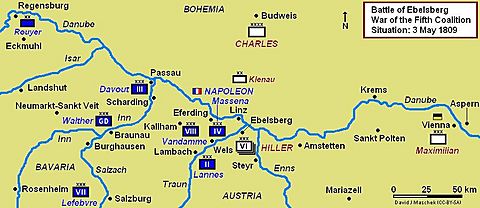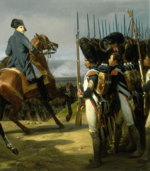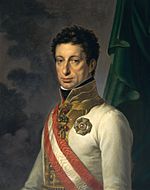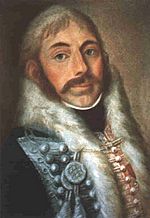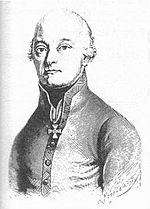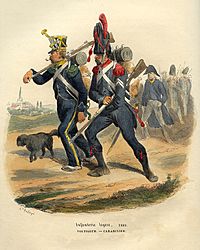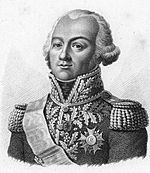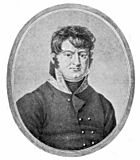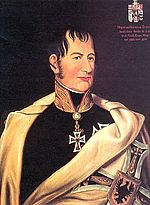Battle of Ebelsberg facts for kids
Quick facts for kids Battle of Ebelsberg |
|||||||
|---|---|---|---|---|---|---|---|
| Part of the War of the Fifth Coalition | |||||||
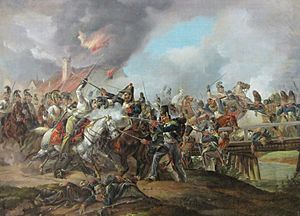 Battle of Ebelsberg by Dietrich Monten, 1825 |
|||||||
|
|||||||
| Belligerents | |||||||
| Commanders and leaders | |||||||
| Strength | |||||||
| 22,000-30,000, 70 guns | 22,100-30,000, 20–48 guns | ||||||
| Casualties and losses | |||||||
| 4,495–8,340 | 3,605–6,000 | ||||||
The Battle of Ebelsberg was a fierce fight that happened on May 3, 1809. It was part of the War of the Fifth Coalition, which was a major conflict during the Napoleonic Wars. In this battle, Austrian forces led by Johann von Hiller defended their positions at Ebelsberg, a town on the Traun River. The French army, commanded by André Masséna, launched a strong attack. They crossed a long, heavily defended bridge and captured the local castle. This forced the Austrian army to retreat. Today, Ebelsberg is a southern part of Linz, located on the south bank of the Traun River, close to where it flows into the Danube River.
Before the battle, the Austrian army under General Hiller was separated from their main forces. They had been pushed back in earlier battles like Abensberg and Landshut. By May 2, Hiller's troops had retreated east to Linz. The Austrians hoped to slow down the French advance towards Vienna. On the morning of May 3, the first French troops, led by Marshal Masséna, caught up with Hiller's rear guard on the west side of the Traun River. The French quickly rushed the bridge and entered the streets of Ebelsberg. At this point, the Austrians started fighting back very hard.
To avoid being pushed into the river, the French sent more soldiers into the street fight. The Ebelsberg castle became a very important target. After Masséna sent in even more troops, the French finally managed to drive the Austrians out of the castle. General Hiller, not wanting the French to recapture the town, ordered his artillery to set the town on fire. Many wounded soldiers from both sides died in the terrible blaze that followed. This battle and its heavy losses were actually unnecessary. Another French army group had already crossed the Traun River further upstream, which would have forced Hiller to retreat anyway.
Contents
Why the Battle Happened
On April 10, 1809, the Austrian army, led by Archduke Charles, Duke of Teschen, invaded Bavaria. Bavaria was an ally of Emperor Napoleon I of France. At first, Napoleon's second-in-command, Marshal Louis Alexandre Berthier, made some mistakes in how he placed the French and German armies. However, the Archduke Charles couldn't take full advantage of this because his troops marched too slowly.
Napoleon soon arrived and took charge. On April 19, Marshal Louis Davout won a tough fight at the Battle of Teugen-Hausen. This victory allowed Davout to join up with Napoleon's main army near Abensberg that evening.
Austrian Retreat and French Pursuit
At the Battle of Abensberg on April 20, General Hiller took command of several Austrian army groups. His forces were weakened because some divisions were sent to other areas. In the battles of Abensberg and Landshut on April 21, Napoleon's army strongly defeated Hiller's troops. This forced the Austrians to retreat southeast, away from Archduke Charles and the main Austrian army. Between April 19 and 21, Hiller lost many soldiers, guns, and wagons. His army shrank significantly.
On April 22, Napoleon marched north to defeat Archduke Charles at the Battle of Eckmühl. Hiller didn't know that the main Austrian army had retreated north of the Danube River. He turned to face a small French force that was chasing him. He even managed to stop Marshal Jean-Baptiste Bessières at the Battle of Neumarkt-Sankt Veit on April 24. But once Hiller learned that Archduke Charles had been defeated, he quickly pulled back southeast.
Archduke Charles sent a message to Hiller on April 24. He ordered Hiller to retreat to Linz, cross to the north bank of the Danube, and join the main Austrian army. Napoleon wanted to catch and destroy Hiller's army. He sent two groups of soldiers after Hiller. Marshal Louis Davout's III Corps, Masséna's IV Corps, and General Dominique Vandamme's VIII Corps took a northern route. Marshal Jean Lannes' II Corps and Bessières' forces took a more southern route.
On April 26, General Claude Juste Alexandre Legrand of Masséna's IV Corps fought with Hiller's rear guard at Schärding. They captured the bridge over the Inn River. That same day, another of Masséna's divisions took over Passau, capturing 400 Austrian soldiers.
Hiller was enjoying his independence from Archduke Charles, who was far away. He was also in easy contact with Emperor Francis I of Austria, who wanted to influence the war. Encouraged, Hiller planned a counterattack against Masséna for April 27. But nothing came of this plan, and the Austrian retreat towards Linz continued.
On May 1, French troops caught up with an Austrian rear guard. A French cavalry unit charged an Austrian infantry group. After their commander was killed, many Austrian soldiers surrendered. On May 2, there was another small fight between French and Austrian forces near Eferding.
After leaving Regensburg, Archduke Charles first retreated to Cham on the border of Bohemia. There, he reorganized his army. From Cham, he marched to České Budějovice. Charles feared Napoleon might follow him into Bohemia. He wrote on May 3 that he planned to fight at České Budějovice. As late as May 6, the main Austrian army was still near that city. However, some smaller groups of Austrian soldiers were operating closer to Linz on the north side of the Danube.
On the night of May 2, Emperor Francis left Linz. He crossed the Danube and hurried to join his brother Charles's army. He left instructions for Hiller to slow Napoleon's advance. Hiller was to take positions behind the Traun River at Ebelsberg and Lambach. If that failed, Hiller could defend the Enns River line further east. Emperor Francis appointed his brother-in-law Archduke Maximilian of Austria-Este to command Vienna. However, most of Vienna's soldiers were not well trained.
On May 2, Marshal François Joseph Lefebvre's Bavarian VII Corps reported fighting with Austrian forces south of Salzburg. Marshal Bessières' cavalry and Marshal Lannes' infantry reached Wels on the Traun River. They found the bridge there burned. Other French divisions were nearby, and Napoleon arrived at Lambach. Davout's III Corps was expected to arrive in Passau on May 3. Napoleon also ordered General Marie François Rouyer to march from Regensburg to Passau. The 12,000-man Imperial Guard reached the area near Braunau am Inn at the beginning of May.
The Battle Unfolds
The Rear Guard Fight
Early on May 3, General Jacob François Marulaz led Masséna's cavalry division from near Eferding. Behind the cavalry came the French infantry divisions. The French cavalry ran into a small Austrian ambush near Wilhering. Around 9:00 AM, the French column marched into Linz and took the road south towards Ebelsberg.
At 3:00 AM, General Hiller started moving his soldiers. He ordered a small Austrian army group to lead the march, followed by the main parts of his other army groups. That morning, Hiller placed four of his brigades as rear guards. As the Austrian wagon train crossed the bridge at Ebelsberg, Hiller's staff lost control. The drivers panicked, and the road became jammed with retreating vehicles and soldiers. Eventually, the crowd of troops and wagons squeezed across the bridge.
However, one Austrian general, Schustekh, was still to the southwest. So, other Austrian generals, Vincent and Radetzky, waited for him on the west bank. They had their forces ready. Schustekh finally appeared with his cavalry and infantry. They began crossing the bridge. Around 10 AM, Marulaz's French cavalry came under fire. While waiting for infantry support, he lined up his cavalry regiments. Soon, General Louis-Jacques Coëhorn's French troops arrived. Masséna himself ordered them to attack the village of Klein München with bayonets.
The Austrian cavalry had already pulled back across the bridge. The Austrian defenders in the village didn't fight well, and Coëhorn's men quickly drove them out. From the direction of Wels, Marshal Bessières arrived with his cavalry and attacked Radetzky, who was covering Schustekh's retreat. Radetzky fought bravely. Meanwhile, another Austrian general, Hoffmeister, tried to make a stand behind a millstream. But his efforts failed as French infantry and cavalry charged forward. Seeing the situation was critical, General Vincent ordered a retreat. Soon, the Austrians were rushing across the bridge in a panic.
Around 11:00 AM, French troops reached the 550-meter-long bridge. French soldiers burst through the gate at the west end and raced across. Austrian artillery fired furiously at the bridge, hitting both their own men and the enemy. But the fire couldn't stop the French advance. The bridge had been set up to be burned, but the officer in charge wasn't there to give the order. Hiller, who had been calmly eating lunch at Ebelsberg Castle, finally realized the danger and started giving orders. Cut off by the fast French advance, some Austrian cavalry swam their horses across the river. An Austrian staff officer even grabbed a French hat, crossed with the enemy infantry, and escaped into the town. Many Austrian soldiers were captured or drowned trying to swim the swollen river.
The Fight for Ebelsberg Town
When Austrian soldiers reached Ebelsberg that morning, Hiller sent them marching further on. He stopped other Austrian troops on the hills east of the town, where they began to cook breakfast. Hiller then sent three battalions of Vienna Volunteers to occupy the town. He also sent three companies to guard the castle and an artillery battery near the castle. He failed to order any defenses to be built before going to the castle for his lunch. Yet, Ebelsberg was a great defensive spot, with the castle on a hill and high ground behind the town.
General Coëhorn immediately led a column up the street towards the castle. But the defenders fired heavily, killing many French soldiers and Coëhorn's horse. Other French troops in the town faced deadly fire from windows and rooftops. Many Austrian cannons on the hills fired shells into the streets. One brave Austrian artillerist, Karl Lenk, caused serious losses to the French with his single cannon before moving to join other guns.
More French brigades joined the battle. These troops were joined by elite cavalry and some artillery. Masséna set up a 20-gun artillery battery on the west bank to fight back against the strong Austrian artillery fire. An Austrian counterattack from the north threatened the French in the town. But by 1:00 PM, a French brigade had taken the marketplace and was trying to outflank the enemy near the castle. As this brigade struggled, another French general, Ficatier, attacked the castle three times but was pushed back.
Two battalions of Vienna Volunteers defending a large cemetery pushed back a French charge with gunfire. Then they charged with bayonets, driving their enemies back. Meanwhile, a third battalion of volunteers attacked the French from the side streets. The three battalions of Vienna Volunteers charged into the town. Reinforced by four more infantry battalions, they drove the French towards the marketplace. As they pushed forward, they captured many prisoners. With the help of two cannons firing at close range, the French desperately held onto the marketplace in house-to-house fighting. An Austrian officer was wounded, and two French colonels were killed. Austrian engineers and howitzer shells started setting some houses on fire, making the situation even worse. Masséna watched helplessly from the other side of the river. Some Austrian engineers set the end of the bridge on fire, but a strong wind put out the flames.
At this critical moment, Colonel Jean Pierre Pouget's 26th Light Infantry Regiment arrived. Amazingly, Pouget got his troops across the bridge with very few losses. Coëhorn appeared and ordered, "You are going to follow this street to a chateau occupied by the enemy. You will attack it." Pouget obeyed and led his men within 40 paces of the castle. The castle, now defended by Austrian soldiers, suddenly erupted in gunfire. Many French soldiers were cut down. Pouget noticed that the deadliest fire came from a barred window above the castle gate. He ordered his men to silence the Austrian fire. But within ten minutes, many officers and soldiers were killed or wounded. As the leading French company was shot down, the rest of his light infantry waited in a column, unable to fire. Losses grew quickly. Pouget finally sent for a Lieutenant Guyot, who was known as a great shot. Guyot got within five meters of the deadly window and started firing as fast as loaded muskets could be given to him. Others followed his example, and the fire from the window began to slow down. Sappers rushed forward and began hitting the gate with their axes. Other men entered the castle through cellar vents and fought their way inside. Soon after the sappers broke down the gate, the Austrian defenders were quickly captured.
Led by General François Roch Ledru des Essarts, the fresh 18th Line Infantry Regiment entered Ebelsberg. One battalion cleared the Austrians out of buildings, while the other two moved to the right to outflank their enemies. Within half an hour, the French had secured the bridge and town gate. However, the bitter fight continued as the French moved out of the east sides of the town and castle. The Austrians stubbornly held their positions on the heights and pushed the French back into the town with cavalry charges. By this time, another French brigade had arrived. Hiller ordered his howitzers and engineers to set fire to parts of the town that hadn't already burned. Sometime after 4:00 PM, the French infantry were cut off from help by the huge fire, which destroyed three-quarters of the houses. As Ebelsberg burned, Hiller ordered a retreat. Since the French cavalry couldn't get through the burning streets, they couldn't chase the Austrians effectively. Surprisingly, one of the few structures that survived was the bridge.
Aftermath of the Battle
The Austrians reported losing 566 killed, 1,713 wounded, and 2,216 captured. This made a total of 4,495 casualties. French losses were also high, with some reports saying over 4,000, including 700 captured. Other sources suggest Austrian losses were as high as 8,340, and French losses around 6,000. It was a very costly battle for both sides.
At 7:00 AM that morning, Marshal Lannes' engineers rebuilt the bridge at Wels. Napoleon didn't know what was happening at Ebelsberg. He ordered Bessières' cavalry and Oudinot's infantry to cross the new bridge and march towards Steyr. When Napoleon finally arrived in Ebelsberg at dusk, he saw many wounded soldiers who had burned to death. Even though he was used to seeing dead soldiers, the emperor was shocked by the many blackened bodies.
Napoleon knew that the terrible slaughter had been completely unnecessary. Lannes' army crossing the Traun River upstream would have forced Hiller to retreat without a battle. The emperor chose not to openly criticize Masséna. He also deliberately reported fewer French losses than there actually were. He understood that the aggressive spirit and bravery shown by his generals and troops would be needed in future battles. So, he gave out awards. For his bravery, Lieutenant Guyot was made a Baron of the Empire and received a lot of money. The next day, the commander of the Imperial Guard praised Colonel Pouget in front of everyone.
Hiller managed to escape from the French. He burned the bridges at every major stream during his retreat. On May 7, the Austrians crossed to the north bank of the Danube River near Krems an der Donau. Hiller left 10,000 troops to retreat on the south bank. Archduke Maximilian held Vienna with 35,000 troops, but many were poorly trained.
On the evening of May 11, French cannons bombarded Vienna. This completely unnerved Archduke Maximilian. He abandoned the city on May 12 and withdrew with most of his soldiers to the north bank of the Danube. He burned all the bridges behind him. Another Austrian general was left behind to surrender the city. The French found a large amount of money, food, ammunition, and 100 cannons that Maximilian failed to take or destroy. The next major battle in the war was the Battle of Aspern-Essling on May 21 and 22.
|


